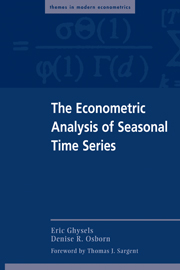Book contents
- Frontmatter
- Contents
- Foreword by Thomas J. Sargent
- Preface
- List of Symbols and Notations
- 1 Introduction to Seasonal Processes
- 2 Deterministic Seasonality
- 3 Seasonal Unit Root Processes
- 4 Seasonal Adjustment Programs
- 5 Estimation and Hypothesis Testing with Unfiltered and Filtered Data
- 6 Periodic Processes
- 7 Some Nonlinear Seasonal Models
- Epilogue
- Bibliography
- Subject Index
- Author Index
5 - Estimation and Hypothesis Testing with Unfiltered and Filtered Data
Published online by Cambridge University Press: 05 June 2012
- Frontmatter
- Contents
- Foreword by Thomas J. Sargent
- Preface
- List of Symbols and Notations
- 1 Introduction to Seasonal Processes
- 2 Deterministic Seasonality
- 3 Seasonal Unit Root Processes
- 4 Seasonal Adjustment Programs
- 5 Estimation and Hypothesis Testing with Unfiltered and Filtered Data
- 6 Periodic Processes
- 7 Some Nonlinear Seasonal Models
- Epilogue
- Bibliography
- Subject Index
- Author Index
Summary
Introduction
In his Foreword to this book, Tom Sargent addresses a fundamental issue pertaining to the econometric treatment of seasonality. One view is that all models are inherently misspecified, since they represent abstractions of a complex reality. When a dynamic optimization-based representative agent structural model is considered, one interpretation could be that the model is exclusively designed to capture business cycle fluctuations. In that context, it could be argued that to fit the model to actual data one should consider seasonally adjusted data to estimate the parameters of the model. This view is elegantly expressed by Sims (1974,1993). Another view is to note that optimization-based structural models should reflect the decision-making process of representative agents facing seasonal fluctuations, and that such fluctuations are in fact an important information source regarding the dynamic propagation mechanism. In light of this view, it would be natural to estimate models with unadjusted data.
Although we cannot settle these issues in this chapter, we will consider some econometric consequences of using seasonally unadjusted and seasonally adjusted data. In a first section we examine the consequences of misspecifying the stochastic structure of seasonality in linear regression models. Hence, the first section deals with some of the pitfalls of using unadjusted data and getting the specification of the seasonality wrong. The remainder of the chapter deals with the consequences of using filtered data.
Information
- Type
- Chapter
- Information
- The Econometric Analysis of Seasonal Time Series , pp. 121 - 138Publisher: Cambridge University PressPrint publication year: 2001
